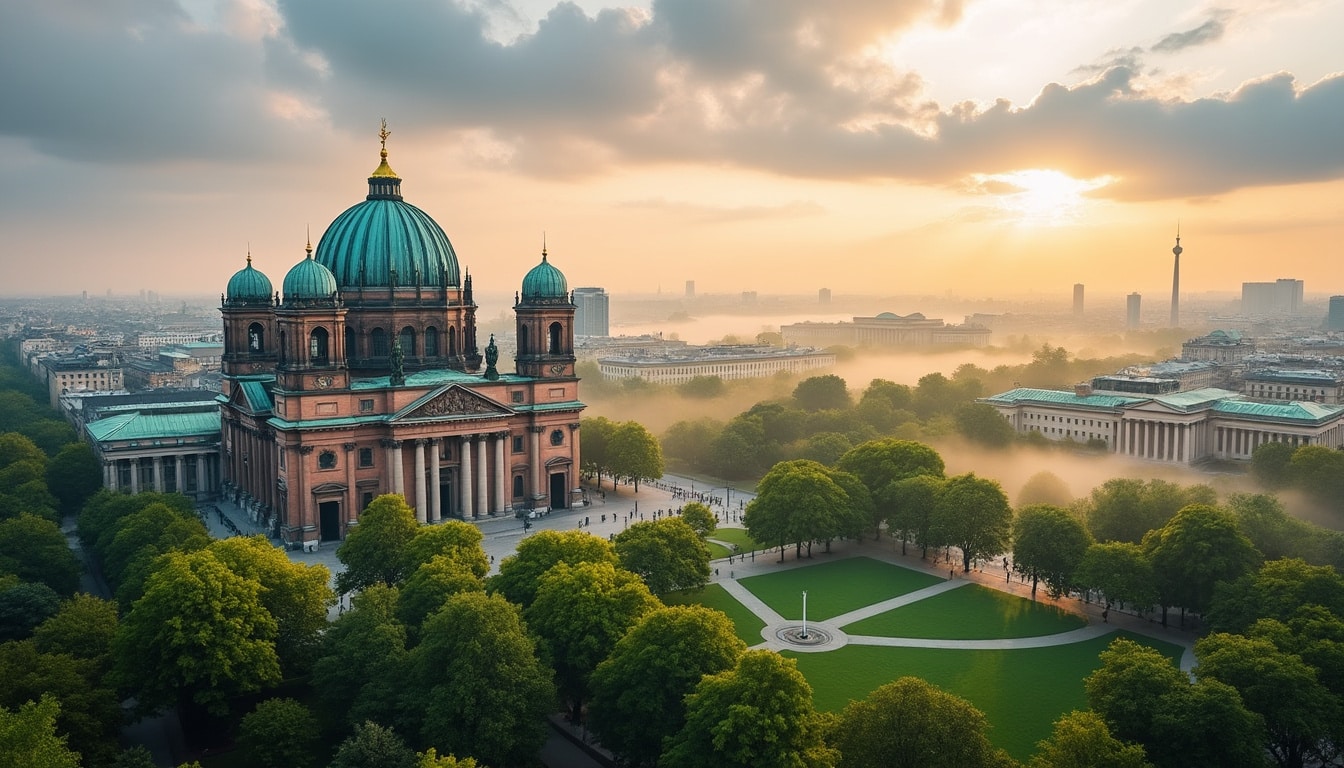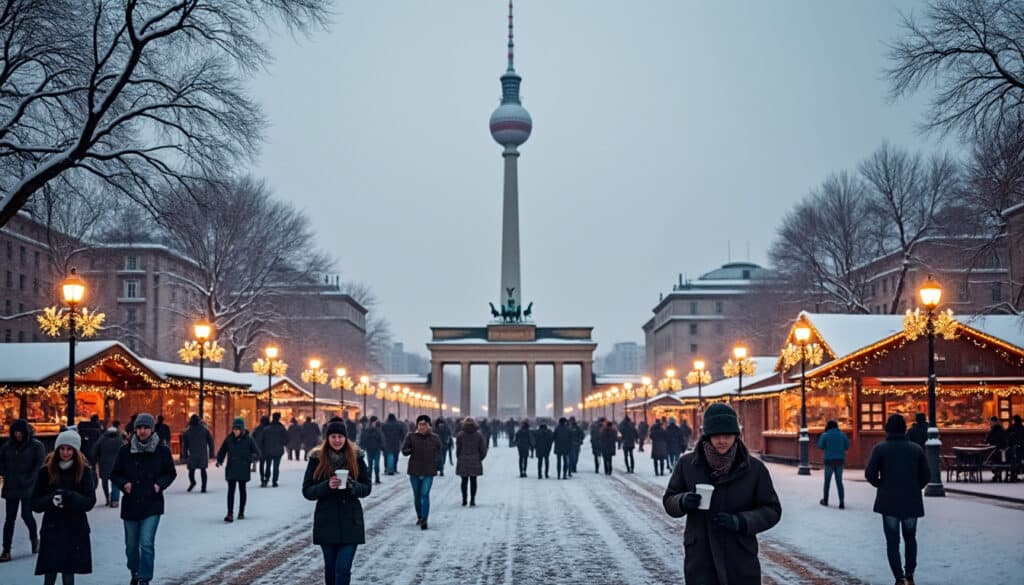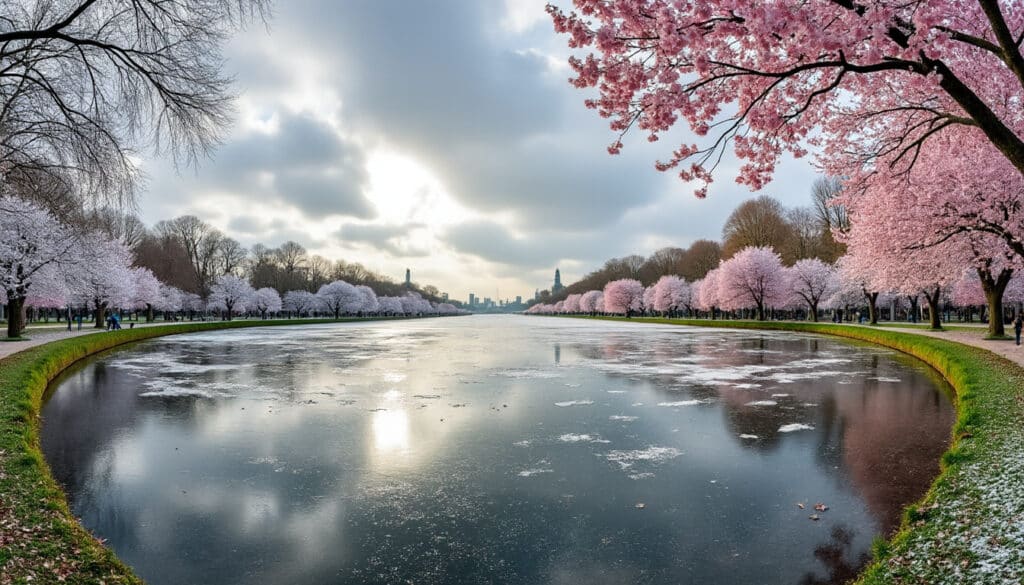Berlin, a vibrant city teeming with history, culture, and a unique urban lifestyle, also presents a unique climate dynamic characterized by varying humidity levels throughout the year. For anyone interested in exploring the German capital, understanding the city’s atmospheric nuances can significantly enhance one’s experience, whether navigating its cobblestone streets or attending a late-night techno party.
Berlin’s Humidity: An Overview Throughout The Year
The climate in Berlin is notably continental, with the temperature variations being more pronounced than in many other European capitals. While temperature fluctuations are an essential aspect of Berlin’s weather, humidity levels also play a crucial role in shaping how living and visiting the city feels. Annually, Berlin experiences an average humidity level of 78%. However, throughout different months, this percentage shifts, creating a dynamic environment.
January sees the highest average humidity levels, hovering around 88%. During this month, the moisture in the air often amplifies the cold, making the average 1°C feel much chillier. February, although slightly less humid at 83%, still maintains a damp ambiance combined with temperatures lingering around 2°C, encouraging thick winter coats and cozy cafés.
As the city transitions to March and April, humidity levels drop to 78% and 70% respectively. With March temperatures averaging 5°C and April warming to 10°C, the decrease in humidity marks the onset of more pleasant, albeit brisk, spring conditions. By May, when the city bursts into life with a flourish of greenery and outdoor activities, the humidity drops to an annual low of 69%, pairing seamlessly with mild temperatures around 14°C.
The warmer months of June through August introduce a contrasting atmosphere. Humidity rises again, resting between 68% to 70%, creating a warm and occasionally muggy environment. However, with temperatures peaking at a comfortable 25°C in July, Berlin becomes a playground for both residents and tourists, who partake in outdoor festivals and events.
A noticeable shift occurs as summer evenings transition into the chill of autumn. By September and October, humidity returns to a higher average of 78% and 84% respectively. As the leaves begin to fall, this humidity contributes to a crisp, invigorating atmosphere, often enhancing the historical allure of the city’s iconic districts.
The year’s close in November and December presents elevated humidity levels again—89%—that envelop Berlin in a misty, almost dreamlike state, setting the perfect stage for its famous Christmas markets and festive gatherings.

The Impact of Humidity on Daily Life in Berlin
Humidity in Berlin heavily influences daily life, impacting everything from local cuisine to clothing choices and home upkeep. The city’s unique climate dynamic demands adaptability and creativity from its residents and visitors alike.
Fashion and Comfort
Clothing choices are a crucial consideration when living or traveling in Berlin. During high humidity months, such as January and November, breathable yet insulating fabrics are essential. A wardrobe staple for locals might include wooly sweaters layered beneath waterproof coats, ensuring warmth against the damp chill.
Moreover, for those planning a summer visit, from June to August, lightweight textiles such as cotton are favored due to the combination of warmth and moderate humidity. This ensures comfort during the day, as one transitions from a museum visit to an alfresco dinner.
In this context, brands like Philips and Dyson have found a niche in climate control products designed for city living. Compact fans and humidifiers cater to residents’ seasonal needs, enabling a more comfortable living environment.
Home Environment
Humidity control is vital in maintaining a pleasant home atmosphere. Devices from brands like Honeywell and Xiaomi are popular for keeping indoor air quality high. The use of dehumidifiers helps prevent mold—a common issue in humid German winters. Portable air conditioners also feature in many homes, particularly during the summer months when humidity and heat combine.
Local Cuisine and Ingredients
Berlin’s humidity influences not only lifestyle but also the local culinary scene. German bread, known for its robust and hearty nature, thrives in such climates. Bakers leverage the moisture in the air to create crispy crusts and fluffy interiors in a tradition that local bakeries proudly uphold.
Technological Adaptations for Humidity Management
As a modern metropolis, Berlin has integrated technology into its daily dealings with humidity. Key technological solutions have optimized living conditions and personal comfort, particularly in combating the adverse effects of humidity.
Smart Home Solutions
With the rise of smart technology, companies like Ecobee and Vornado offer systems that autonomously adjust home environments. These devices not only adapt temperature and humidity levels but also provide data-driven insights, enhancing both comfort and energy efficiency.
For instance, WeatherTech offers real-time humidity tracking devices. These gadgets are invaluable for homeowners who need to manage humidity levels proactively to preserve furnishings and maintain indoor air quality.
Such advancements underscore the growing trend of smart urban living in Berlin, where technology meets comfort for a seamless day-to-day experience.
Transportation and Public Facilities
Berlin’s public transport systems have also embraced technological solutions to maintain comfort. Trains and buses now frequently incorporate air conditioning systems, ensuring that high humidity levels during summer do not disrupt the commuting experience. Moreover, public buildings, museums, and entertainment venues often feature state-of-the-art climate control systems.
This integration of technology showcases how Berlin leads in adapting its infrastructure to its climatic conditions, fostering a convenient and pleasant urban experience.
Green Spaces and Urban Planning
In addition to technology, Berlin’s city planning embraces expansive green areas that naturally alleviate humidity effects and create pleasant microclimates. Parks like Tiergarten and Tempelhofer Feld are excellent examples of how urban design meets environmental needs. During humid months, these spaces provide refreshing retreats where locals and tourists alike can unwind.
Berlin and The Human Experience Under Varying Humid Conditions
Humidity not only affects the physical landscape of Berlin but also profoundly impacts its culture and day-to-day human interactions. With a context-sensitive approach, one can better understand how Berliners have adapted to and thrive in their ever-changing atmospheric environment.
Social Life and Outdoor Activities
Berlin’s vibrant social life is deeply intertwined with its environmental conditions. During the warmer, humid summer months, the city’s numerous parks and outdoor venues become the central hub for social gatherings. Beer gardens fill with chatter and laughter, with mild humidity enhancing the freshness of brewed beverages and snacks.
During colder months, however, humidity serves as a backdrop to cozy indoor experiences. Cultural venues such as the infamous techno clubs skillfully manage humidity, ensuring that despite the packed dance floors, comfort remains central. Venues like Berghain are known for their expert climate control, which encourages extended visits, even during cold, moisture-heavy winters.
Sustainability and Community Initiatives
Berlin also sees an interesting intersection between humidity and sustainability. Community-driven initiatives have emerged focusing on local gardening projects and urban greening activities. The adoption of sustainable practices in cultivating urban greenery helps manage local microclimates, contributing to both aesthetic and climatic benefits.
Organizations in Berlin are increasingly pushing such projects with strong support from local communities. These efforts provide both ecological benefits and spaces for communal interaction and learning.
The Intersection of Creativity and Weather
The climatic conditions, of which humidity is a defining factor, play into Berlin’s reputation as a hub of creativity and artistic expression. Many artists find inspiration in the interplay of weather and the cityscape, producing works that reflect the unique atmospheric conditions.
Maintaining Health and Wellbeing During Berlin’s Humid Weather
Humidity can have intricate effects on health and wellbeing and knowing how to mitigate these effects is crucial. The interplay of weather conditions demands proactive measures to ensure both physical comfort and mental wellness.
Managing Physical Comfort
From high summer to cold winter, managing comfort can be a challenge. Experts recommend several strategies to maintain comfort indoors and out:
With the correct products and approaches, individuals can enjoy year-round comfort within Berlin’s diverse climate.
Navigating Health Impacts
Humidity, especially when fluctuating, can also affect physical health, particularly respiratory systems and skin conditions. Proper hydration, both internal and external, is essential. During summer, staying in shaded and ventilated areas can prevent heat-related issues. In winter, maintaining healthy indoor air is vital to avoid colds and flu exacerbated by dampness.
Berlin’s pharmacies often stock a range of seasonal medications, emphasizing preparation and prevention. Discussing needs with local pharmacists can yield personalized solutions adapted to the weather’s demands.
Psychological Impacts and Wellbeing Activities
Weather conditions in Berlin have long been associated with psychological effects. Seasonal Affective Disorder (SAD) is a concern for many, particularly during dark, humid winters. Maintaining mental health involves embracing the arts and social engagements the city offers.
Regular visits to Berlin’s abundant cultural sites, such as museums and galleries, provide mental stimulation and a welcomed distraction from weather-induced blues.
FAQ About Humidity in Berlin
- ❓ Are there times of the year when Berlin’s humidity can be particularly challenging?
Yes, the transition periods in spring and autumn often see fluctuating humidity levels, which can be a challenge. During these times, investing in adaptable clothing and using dehumidifiers at home is recommended.
- 🌡️ How do locals cope with summer humidity?
Locals enjoy outdoor activities in parks and along waterways. Additionally, many homes and public spaces are equipped with efficient air conditioning systems to handle the heat and humidity.
- 🏠 What are some best practices for managing humidity indoors during winter months?
Using slow, consistent heating and dehumidifiers helps maintain a comfortable home environment. It’s also common to see humidifiers to add necessary moisture when conditions dry out.
For additional insights into Berlin’s climate and weather trends, you can explore Berlin Avenue’s climate guide or understand how cold weather influences the city by visiting their detailed page on Berlin’s cold weather.

Navigating the climate in Berlin involves understanding its unique variations across the seasons. The city, known for its cultural vibrancy and historical significance, experiences a maritime temperate climate that influences both residents and tourists. Whether you’re strolling the streets of…

As winter descends upon Berlin, the city’s vibrant streets transform into a mystical canvas painted with frosty hues. Locals and visitors alike brace for the biting chill, exploring unique ways to embrace the city’s cold climate. From cozy cafés to…

Flooding and natural risks in Berlin
The vibrant city of Berlin, known for its rich history and dynamic urban culture, faces its share of natural challenges, particularly flooding. With its intricate network of rivers and canals, Berlin’s flood risks have increasingly become a focal point for…

Berlin, the vibrant capital of Germany, is no stranger to fluctuating weather patterns. As summer approaches, it transforms into a bustling hub where residents and tourists alike bask in the warmth of the season. With its distinct urban culture and…

Is Berlin warm throughout the year?
Berlin, the bustling capital of Germany, is a city rich in history, culture, and diverse climate patterns. As a key player in the cultural and political landscape of Europe, understanding Berlin’s weather throughout the year is crucial for both residents…

Rain and precipitation in Berlin
Berlin, well-known for its rich historical and cultural heritage, is also characterized by its distinct climate patterns. The city receives an average of 591 mm of rainfall annually, making rain and precipitation a significant aspect of life here. This article…

Berlin, Germany’s vibrant capital, experiences a fascinating array of seasonal changes throughout the year. Each season brings its unique charm to this bustling metropolis, making Berlin a captivating destination no matter the time of year. From the Winter Wonderland of…

The city of Berlin, capital of Germany, boasts a rich tapestry of culture and history, but many might not realize the weather here is just as compelling. Situated at a latitude of approximately 52 degrees north, Berlin experiences a moderately…

Berlin, with its vibrant culture and rich history, attracts millions of tourists each year. A key factor to consider when planning your visit is the weather, which shifts dramatically from month to month. This article provides an in-depth look at…

What is the weather like in Berlin?
Berlin, the vibrant capital of Germany, is known not only for its rich history and dynamic cultural scene but also for its unique weather patterns that can vastly vary throughout the year. Whether you’re a resident soaking in the Berlin…



